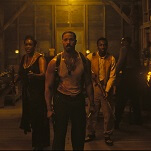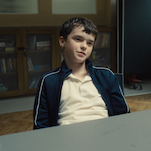Space Oddity Case File #141: Solaris

There came a point in the creation of my memoir when I started thinking of myself less as a writer and more as a literary exorcist. I wasn’t telling stories so much as I was conjuring up old demons. I began to think of the people in my memoir that I’d lost touch with as ghosts who existed only in the past tense. Oh sure, some part of me realized they were alive as I was, if not more so—I’m not very good at this whole “life” thing—and were going about their daily business, but some lizard part of my brain assumes that, in a strange fundamental sense, people cease to exist the moment they leave my field of vision.
The world is filled with these strange ghosts. Even more disconcertingly, as my book neared its release date, some of these ghosts of my past began e-mailing, calling, befriending me on various social networking sites, and generally behaving in a most unghostly fashion. Part of me wanted to scream, “No! You belong in memory, in the past, in moments lost forever, not in my inbox!” Conjuring up spirits can be a tricky proposition.
Steven Soderbergh’s 2002 adaptation of Solaris, a 1961 novel by Polish science-fiction writer Stanislaw Lem, is obsessed with these elusive specters of memory and the delicate interplay of past and present. It’s about what happens when the ghost of one man’s past pops up on a spaceship looking to make a new beginning, and the tragedy that ensues. There are really only two kinds of science-fiction films: the kind with Wookies, and the kind that would benefit from the addition of Wookies. Solaris belongs in neither category. In a genre of epics, it’s boldly intimate; in a realm of spectacle, it’s a film of almost heroic quiet.
Coming on the heels of the widely reviled Full Frontal, it served notice that writer-director Steven Soderbergh was going to do whatever the hell he wanted, even if it meant playing to a tiny audience or losing studios a bundle. Soderbergh is a one-man New Wave who has figured out a way to satisfy his restless muse while keeping one foot firmly in the realm of mainstream commercial filmmaking. He’s living the cinephile dream, cranking out movies at a rapid clip while shifting effortlessly between genres, styles, and budgets.
In the past decade alone, he’s executive produced groundbreaking, reality-bending, wholly improvised television comedy-dramas populated with politicos playing themselves (2003’s intriguing K Street) and actors doing likewise (Unscripted). He wrote and directed a quirky digital-video comedy of Hollywood manners with major movie stars (Full Frontal). He went über-indie with the grimly proletarian 2005 crime drama Bubble, and got Warner Bros. to finance and release a black-and-white Michael Curtiz homage (2006’s The Good German). Oh, and he made a two-part, wildly uncommercial, four-and-a-half-hour biopic of Che Guevera. And a zeitgeist-friendly Godardian digital-video drama (The Girlfriend Experience) starring a porn star. Other filmmakers have long lists of dream projects they’d love to get made someday, maybe, if fortune smiles upon them. Soderbergh gets a dream project made every couple of months. He’s a champion talker, but more importantly, he’s a doer who leads a charmed life. Verily, he is a god among men.
It would be bad enough if Soderbergh merely wrote, directed, and/or produced a nonstop barrage of provocative, eclectic films and television shows. But that isn’t enough for our greedy little friend. No, he has to shoot his own films and edit them under pseudonyms. Quite frankly, I find it a little sickening that one bald, bespectacled little man is able to do so many things so brilliantly. It isn’t fair. Soderbergh is throwing off the curve. Maybe the reason Hollywood is filled with so many mouth-breathing troglodytes is because he’s hogged all the talent. Either he’s one of the most remarkable talents in American film, or there’s a very busy genie out there granting all his wishes. Alternately, he’s cloned himself Multiplicity style, and has six or seven exact copies helping him get shit done.
So while directing a $50 million adaptation of a seminal science-fiction novel that was already the source material for a masterpiece—Andrei Tarkovsky’s 1972 film of the same name—would be a huge gamble for anyone else, 2002’s Solaris only ranks about a 5 on the Soderbergh risk-ometer. Also adding to the riskiness of the endeavor: Solaris has the proverbial cast of several, it features almost no action, and it primarily deals with the psychological torment of a single lost man in space.
Handsome actor George Clooney plays a heartbroken psychiatrist enshrouded in a fog of despair following the suicide of mentally ill wife Natascha McElhone. Clooney is roused from his stupor by a despairing message from a friend beckoning him to travel to a ship hovering outside a mysterious entity known as Solaris, and rescue what remains of the crew. Clooney arrives to find the ship in the grips of what Ren and Stimpy might call space madness. Something has gone horribly, horribly awry on a spiritual, metaphysical, and physical level. Clooney’s friend has killed himself, leaving Viola Davis, Jeremy Davies, and a spooky little mystery boy as the ship’s sole inhabitants. Or so it would seem.
When Clooney asks Davies what’s happening to the ship and its deeply freaked-out passengers, Davies delivers a wonderful line that succinctly captures a horror and mystery so vast and mind-blowing, it can’t be put into something as reductive as words: “I could tell you what’s happening. But I dunno if that’d really tell you what’s happening.”








































